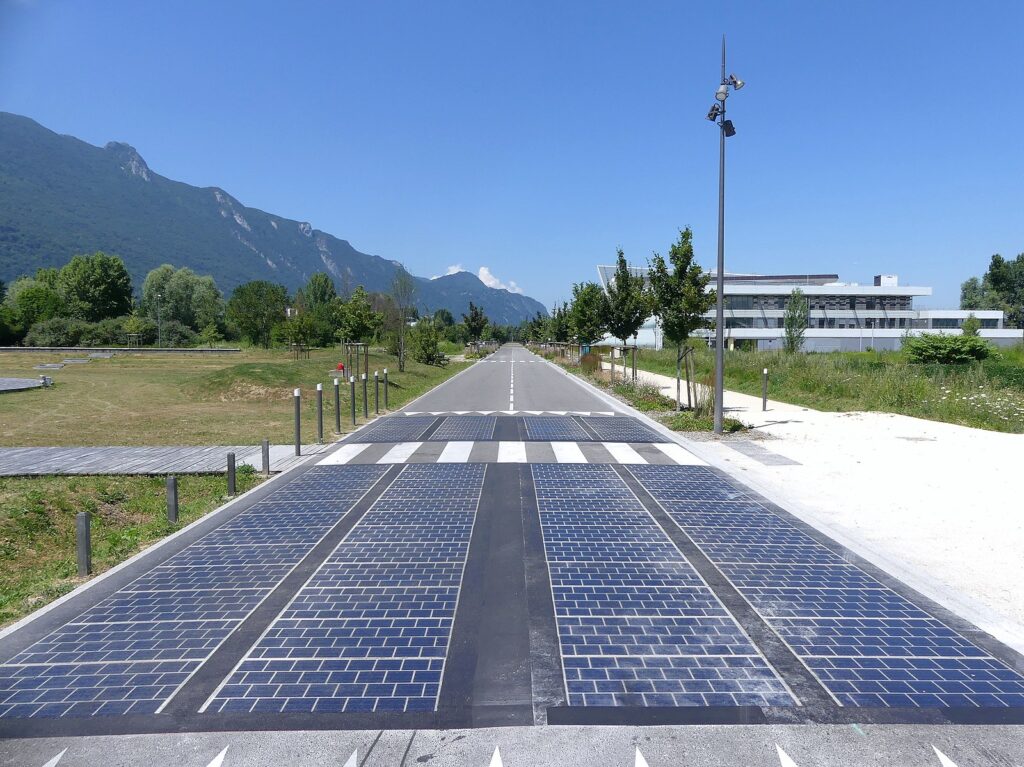Letter: Are Solar Roads An Option For Amherst?

Small portion of a solar powered road in ''Savoie Technolac'' science and technology park, the first installed in Savoie, France. Photo: Wikimedia Commons (CC BY-SA 4.0)
The following letter was sent to the Amherst Town Council on May 19, 2023
With Amherst needing to provide a certain amount of solar collection, to meet state standards and also help save the planet, combined with that so many of our roads are in need of repaving, could we explore rebuilding our roads to be solar collectors? This may be our chance to leapfrog over traditional solutions and invest in the future. I don’t know how much a mile of solar roadways would cost, but I’ve heard from town leaders that just repaving with asphalt is $1,000,000 per mile, so there’s no budget way to fix our crumbling roads, and no better expanse of surface area where the sun does shine.
Ira Bryck
Ira Bryck has lived in Amherst since 1993, ran the Family Business Center for 25 years, hosted the “Western Mass. Business Show” on WHMP for seven years, now coaches business leaders, and is a big fan of Amherst’s downtown.

It would also have the advantage of not using forests for that very sub-optimal use; and find a way around the too high demand on 3 local paving companies who lack capacity to serve all their customers; help avoid the catastrophes that have occurred from the negligence of the very same companies Amherst is dealing with; and make national news as an innovative town that solves several birds with 1 stone.
I hope someone in town leadership will at least suggest the idea be explored. It seems that it’s in beta phase, and maybe there is a win/win in even having a couple of test streets done with a large donation from the state or fed or public/ private partnership.
I nominate Red Gate Lane, where I regularly almost get killed on my bike. And N Pleasant St downtown, done one lane at a time.
Solar roadways are an interesting and creative idea but it’s not apparently ready for prime time. Cost estimates that I have seen (see links below) have run between $8M – $9M /mile and there are still plenty of problems in terms of safety, maintenance, and power generation.
One of the things that makes the idea so appealing is that roads offer a prodigious supply of potential surface to cover with solar panels that would obviate the need to cut down forests or cover farmland.
https://arstechnica.com/cars/2016/12/worlds-first-solar-road-opens-in-france/
https://www.ecowatch.com/solar-roadways-too-good-to-be-true-2655025285.html
https://solarroadways.com/specifics/numbers/
Ira, I’m sorry to hear you almost get killed on your bike. Let’s get a couple of stop signs on RG to slow traffic, because as the cut-through from College to Main to Strong, it gets a lot of fast traffic. At the corner of Red Gate & Hills in particular, a three-way stop would be welcome.
I have also seen videos of early failures of solar roads and know it’s expensive, and maybe the time isn’t right.
But are there steps to take in this direction, rather than allow distant and giant energy companies put huge solar arrays in forests?
People say there’s not enough surface area on houses and parking lots, but we have 100+ miles of roads in Amherst, there must be some solar technology that can be built along there, and using that land might avoid the lawsuits by those companies and their local partners, against towns who aim to preserve forests and all they do for the planet.
PS: thank you Laura, for proposing a stop sign on Red Gate & N Whitney, a very awkward intersection. But it’s the Baja quality of the street that is the big danger there and on many roads in Amherst. Fixing much of the 100 miles of roads, at $1mm per mile really eats into our $92mm annual budget.
Does anybody remember covered bridges?
The covering protects the roadway surface and the supporting structure of the bridge from the weather….
Have you seen the photovoltaic (PV) solar canopies over the parking lots at UMass?
Their supporting structures are more expensive than the posts used to support PV panels at solar “farms” or “forests, but the canopies also provide weather protection to vehicles and the pavement beneath them; along busy roadways, they could also be incorporated into acoustic protection for neighboring areas….)
Now, let’s combine these two ideas: Rather than putting PV in the pavement, consider canopies over more parking areas and perhaps some busy roadways!
By covering with PV panels the area (roughly 100 sq ft or about 10 square meters) of a roadway or parking lot each that motor vehicle occupies, the typical electric power (about 1 kilowatt) needs of each person are met.
And since the number of parking spaces exceeds (by many times) the number of people, the capacity is there (including roadway canopies would of course increase the capacity by another order of magnitude).
What about the cost of solar PV canopies?
According to this supplier
https://www.solarelectricsupply.com/commercial-solar-systems/solar-carport
they are much cheaper (about 1/10th) than the figure Art mentioned (about $1M per mile-long lane of roadway, around 60,000 sqft or 6,000 square meters) for the cost of in-pavement PV roadways. And almost surely the combined maintenance cost of solar canopies and ordinary pavement would be less than that for PV pavement.
So maybe it comes down to aesthetics? Most folks prefer to park in the shade, and if you had the choice of looking down on a lot full of cars or shimmering blue rectangles, which would you choose?
Please give this some thought, as this fellow already has:
https://e360.yale.edu/features/putting-solar-panels-atop-parking-lots-a-green-energy-solution